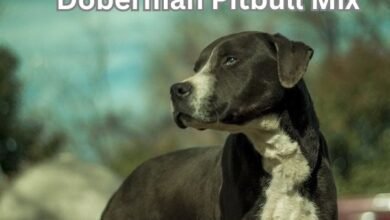
Can Dogs Eat Butternut Squash? It’s a question many dog owners ask when looking to add healthy treats to their pet’s diet. The quick answer is yes—dogs can enjoy butternut squash, but only when it’s prepared carefully and served in moderation. While this vegetable is packed with vitamins and fiber that can benefit your furry friend, there are some surprising dangers you might not know about. From the risks of feeding raw squash to potential choking hazards from seeds and skin, it’s important to understand these precautions before sharing this tasty treat with your dog.
In this article, we’ll expose eight critical dangers to watch out for to keep your dog safe and healthy while enjoying the benefits of butternut squash.
What Is Butternut Squash?
Butternut squash is a type of winter squash with a sweet, nutty flavor. It has a creamy, orange flesh inside a tough, tan skin. Most people enjoy it roasted, mashed, or in soups.
Definition and Nutritional Profile
Butternut squash is packed with nutrients that are great for dogs and humans alike. Here’s what makes it special:
- Rich in vitamins: It contains vitamins A, C, and E, which support healthy skin, eyes, and the immune system.
- High in fiber: Good for digestion and keeping your dog’s tummy happy.
- Low in calories: Helps maintain a healthy weight.
- Contains antioxidants: These protect cells and fight inflammation.
Why Pet Owners Consider It as Dog Food
Many pet owners look for healthy, natural snacks or meal additions for their dogs. Butternut squash is often chosen because:
- It’s a tasty alternative to processed treats.
- It’s easy to prepare—just steam or bake, then mash into small pieces.
- It supports digestion due to its fiber content.
- It can help with weight management thanks to low calories.
- It’s generally safe and enjoyed by most dogs.
Next time you’re cooking, consider sharing a little roasted butternut squash with your furry friend—it’s a wholesome treat that feels like a real snack! Just remember to avoid any added salt, spices, or sugar.
8 Surprising Dangers of Butternut Squash for Dogs
1.Raw Butternut Squash Can Cause Digestive Blockages
Can Dogs Eat Butternut Squash? Butternut squash is a tasty, healthy vegetable that many dogs can enjoy. It’s packed with vitamins and fiber, making it a great treat in small amounts. But before you serve it up, there’s one important thing to know: raw butternut squash can be risky for your dog.
Raw butternut squash is very fibrous and tough. This means it can be hard for your dog to chew and digest properly. Here’s why this matters:
- Difficult to Digest: The fibrous texture can slow down digestion and irritate your dog’s stomach. It might lead to stomach pain or discomfort.
- Choking Hazard: Large chunks or hard pieces can get stuck in your dog’s throat, causing choking.
- Intestinal Blockages: If swallowed in big pieces, raw squash can cause blockages in your dog’s intestines. This is a serious problem and might need emergency care.
What to Do Instead
To keep your dog safe and happy:
- Always cook butternut squash before feeding it to your dog. Cooking softens it, making it easy to chew and digest.
- Cut the squash into small, bite-sized pieces.
- Avoid adding seasonings like salt, butter, or spices.
In summary, raw butternut squash may seem healthy but can cause problems for your dog. Cook it first to make a delicious, safe treat that your pup will love!
2.Seeds Present Choking and Obstruction Risks
When it comes to feeding butternut squash to your dog, it’s important to be careful with the seeds. These small seeds might seem harmless, but they can cause serious problems, especially for smaller dogs.
Why Seeds Are Risky:
- Irritate the throat: Seeds can get stuck or scratch the lining of your dog’s throat, causing discomfort or pain.
- Block the digestive tract: If swallowed whole, seeds might cause a blockage in your dog’s intestines. This can lead to vomiting, loss of appetite, or even an emergency situation.
Smaller Dogs Are More Vulnerable:
- Because of their tiny throats and digestive systems, small dogs are at a higher risk. Even one or two seeds can be enough to cause trouble.
- Always remove seeds completely before giving butternut squash to smaller breeds.
Tips to Keep Your Dog Safe:
- Scoop out and discard all seeds before cooking or serving.
- Chop the squash into bite-sized pieces to avoid choking hazards.
- When in doubt, stick to seedless, cooked squash as a tasty treat.
By taking these simple steps, you help keep your furry friend happy and healthy while they enjoy the goodness of butternut squash!
3.Tough Skin Can Damage Teeth and Digestive System
Butternut squash has a thick, tough skin that might seem harmless, but it can actually cause problems for your dog. Here’s why:
- Hard on Teeth: The skin is very firm and can be tough for your dog’s teeth to bite through. Trying to chew it might lead to broken or cracked teeth, which can be painful and costly to fix.
- Digestive Trouble: Even if your dog manages to swallow pieces of the skin, it’s hard to digest. This can cause stomach upset, blockages, or discomfort, especially in smaller dogs or those with sensitive tummies.
To keep your pup safe, it’s best to peel the butternut squash before offering it as a treat or part of their meal. This simple step protects their teeth and helps avoid any digestive issues. Your dog will enjoy the soft, sweet flesh without any trouble!
4. Allergic Reactions Are Possible
Just like people, dogs can sometimes have allergies to certain foods—even healthy ones like butternut squash. It’s important to keep an eye out for any signs that your dog might not be reacting well to this tasty treat.
Signs of Butternut Squash Allergies in Dogs
Watch for these common symptoms after your dog eats butternut squash:
- Itching or scratching more than usual
- Red or inflamed skin
- Swelling around the face, ears, or paws
- Vomiting or diarrhea
- Hives or bumps on the skin
- Excessive licking or chewing of certain areas
If you notice any of these signs, stop feeding butternut squash immediately.
When to Seek Veterinary Attention
Sometimes allergies can get serious. You should contact your vet right away if your dog shows:
- Difficulty breathing or wheezing
- Swelling of the face, lips, or throat
- Severe vomiting or diarrhea
- Weakness or collapse
Your vet can help determine if butternut squash is the cause and recommend the best treatment to keep your furry friend safe and comfortable.
5. High Fiber Content Can Cause Digestive Upset
Butternut squash is packed with fiber, which is great for your dog’s digestion in small amounts. However, too much fiber can cause problems like diarrhea and gas. When your dog eats excess fiber, their stomach may struggle to break it down, leading to loose stools or uncomfortable gas.
To keep your pup happy and healthy, it’s important to control the portion size of butternut squash. Here are some easy tips:
- Start small: Offer just a teaspoon or two for small dogs and a tablespoon for larger dogs.
- Watch for signs: If your dog shows tummy troubles like diarrhea or bloating, cut back or pause the squash.
- Moderation is key: Treat butternut squash as a snack or mix-in, not a main meal.
By keeping portions in check, your dog can enjoy butternut squash without the digestive upset.
6.Seasoned Squash Contains Toxic Ingredients
When you think about sharing butternut squash with your dog, it’s important to remember that not all preparations are safe. Many squash dishes are seasoned with ingredients that can harm your furry friend.
Dangers of Garlic, Onions, and Nutmeg in Squash Dishes
- Garlic and Onions: These common seasonings can damage a dog’s red blood cells. Even small amounts may cause weakness, vomiting, or breathing problems.
- Nutmeg: Often used to add flavor, nutmeg is toxic to dogs and can cause seizures, increased heart rate, or even death.
Why Plain Preparation Is Essential
- Always serve butternut squash plain and cooked without any added spices or seasoning.
- Boiling, steaming, or baking the squash is best — this keeps it safe and easy to digest.
- Avoid butter, oils, salt, or sugar when preparing squash for your dog.
By sticking to plain butternut squash, you can give your dog a tasty and healthy treat without worrying about harmful spices. It’s a simple way to keep your pet safe and happy!
7. Overconsumption Can Lead to Weight Gain
Butternut squash is a healthy treat for dogs, but like anything, too much can cause problems. It’s important to remember that snacks should only make up a small part of your dog’s diet.
Watch the Calories
- Butternut squash contains natural sugars and calories.
- Feeding too much can add up quickly and lead to extra pounds.
Follow the 10% Treat Rule
- Treats and snacks should not exceed 10% of your dog’s daily calories.
- This helps keep their weight in check and avoids unbalancing their main meals.
Long-Term Health Concerns
- Constant overfeeding can cause weight gain, leading to risks like joint pain, diabetes, and heart issues.
- Keeping treats moderate supports your dog’s overall health and happiness.
Remember, treats should be occasional fun, not a regular part of the diet. A few small pieces of butternut squash now and then are great, but moderation is key!
8. Risk for Dogs with Underlying Health Conditions
When it comes to feeding butternut squash to your dog, it’s important to think about any health issues they might have. Some dogs need extra care, and butternut squash might affect them differently.
Special Considerations for Diabetic Dogs
- Butternut squash contains natural sugars, though it’s low on the glycemic index.
- For diabetic dogs, these sugars can still impact blood sugar levels.
- Always monitor your dog’s reaction when introducing butternut squash.
- Start with small amounts to see how your dog’s body handles it.
When Veterinary Consultation Is Necessary
- If your dog has diabetes or other chronic health issues, talk to your vet before adding butternut squash to their diet.
- Consult your vet if you notice unusual symptoms after feeding butternut squash, like vomiting, diarrhea, or changes in appetite.
- A vet can provide tailored advice based on your dog’s specific health needs.
Remember, keeping your furry friend healthy means making careful food choices. When in doubt, your vet is the best guide!
Health Benefits of Butternut Squash for Dogs (When Safe)
Can Dogs Eat Butternut Squash? Butternut squash can be a healthy and tasty treat for your dog when given properly. It’s packed with nutrients that support your pup’s health. Here’s a simple look at the benefits of butternut squash and why it can be a great addition to your dog’s diet.
Fiber for Digestive Health
Butternut squash is high in fiber, which helps your dog’s digestion stay smooth and regular. If your dog has occasional constipation or upset tummy, a little squash might help keep things moving nicely.
Vitamin A for Immune System and Vision
This squash is rich in vitamin A, which supports your dog’s immune system and helps keep their eyes healthy. Think of it as a natural boost to help your dog stay strong and see well.
Vitamin C for Immune Support
Vitamin C is an antioxidant that helps your dog fight off illness. Butternut squash provides a gentle dose of this vitamin, adding extra protection to your dog’s immune defenses.
Beta-Carotene and Antioxidants
The bright orange color of butternut squash comes from beta-carotene and antioxidants. These nutrients help fight cell damage and support overall health, keeping your dog feeling young and energetic.
Low-Calorie Treat Option
If you want a low-calorie snack for your dog, butternut squash is a great choice. It’s filling but won’t add extra pounds. Just steam or bake it plain, and offer small portions as a treat.
Always cook butternut squash without any seasoning, and remove seeds and skin before giving it to your dog. Start with small amounts to see how your dog reacts, and if you’re unsure, check with your vet. Your furry friend might just love this tasty and healthy snack!
How to Safely Prepare Butternut Squash for Dogs
Can Dogs Eat Butternut Squash? Yes, dogs can enjoy butternut squash! It’s a tasty and healthy treat packed with vitamins and fiber. But it’s important to prepare it safely to keep your furry friend happy and healthy.
Before sharing butternut squash with your dog, make sure it’s cooked and plain. Raw squash is hard to digest and the skin can be tough to chew.
Step-by-Step Cooking Instructions
- Wash the squash thoroughly to remove dirt.
- Peel the skin completely, as it can be hard for dogs to digest.
- Cut the squash into small cubes or slices, about 1-inch pieces.
- Remove seeds to avoid any choking risk.
- Cook the squash by boiling or steaming until soft—this usually takes about 15-20 minutes.
- Let it cool before serving to avoid burning your dog’s mouth.
Proper Portion Sizes
- Start with a small amount—about 1-2 teaspoons for small dogs and up to 2 tablespoons for larger dogs.
- Watch for any signs of upset tummies before making it a regular treat.
- Butternut squash should only be a small part of their diet, not a main meal.
Safe Serving Methods
- Serve plain, without added salt, spices, butter, or sugar.
- Mix the cooked squash into your dog’s regular food or give it as a standalone snack.
- Avoid canned squash with preservatives or added ingredients.
Giving butternut squash prepared this way is a great way to add variety and nutrition to your dog’s diet. Just remember to keep it simple and safe for their tummy!
Alternative Safe Vegetables for Dogs
Can Dogs Eat Butternut Squash? Yes, dogs can safely eat butternut squash when it is cooked and served without skin or seeds. This delicious vegetable is packed with vitamins like A and C, fiber, and minerals that support your dog’s immune system, digestion, and overall health. Many dogs enjoy its naturally sweet taste, making it a tasty and healthy treat option.
- Carrots: Great for teeth and low in calories
- Green beans: High in fiber and vitamins
- Sweet potatoes: A good source of vitamins and energy
- Peas: Provide protein and antioxidants
- Zucchini: Low in calories and good for hydration
Other Dog-Safe Squash Varieties
- Acorn squash: Also rich in nutrients but served cooked and skin removed
- Pumpkin: A popular squash that helps with digestion and is great for coat health
- Spaghetti squash: Can be fed cooked without seeds and skin
- Delicata squash: Safe in moderation when cooked properly
Comparison with Pumpkin Benefits
- Both butternut squash and pumpkin are rich in fiber, which aids digestion and can help regulate bowel movements.
- Pumpkin is often recommended for dogs with diarrhea or constipation due to its gentle effect on the digestive system.
- Both contain beta-carotene, which converts to vitamin A, supporting immune function and skin health.
- Butternut squash tends to be sweeter and may be more appealing to some dogs as a treat.
- Both should be cooked plain without added salt or seasonings for safe feeding.
Butternut squash is a nutritious and safe vegetable for dogs when cooked and properly prepared. It pairs well with other dog-safe veggies and shares many health benefits with pumpkin, making it a great addition to your furry friend’s diet. Just remember to serve in moderation and always remove skin and seeds before feeding.
Warning Signs to Watch For
These signs may mean your dog isn’t feeling well after eating butternut squash:
- Vomiting or frequent upset stomach
- Diarrhea lasting more than a day
- Signs of abdominal pain, such as whining or restlessness
- Loss of appetite or lethargy
- Sudden changes in behavior or mood
If you see any of these, give your vet a call to discuss what you’re seeing.
Emergency Situations Requiring Immediate Care
Seek urgent veterinary help if your dog:
- Has trouble breathing or is choking
- Shows signs of severe allergic reaction like swelling of the face, lips, or tongue
- Is vomiting repeatedly or can’t keep fluids down
- Becomes very weak, collapses, or isn’t responding normally
In these cases, quick action can save your dog’s life. Better safe than sorry!
Butternut squash can be a healthy treat, but knowing when to act keeps your dog happy and safe. Always watch your pup closely after trying new foods, and don’t hesitate to reach out to your veterinarian when in doubt.
Conclusion
Butternut squash can be a healthy and tasty treat for your dog when served properly. It’s packed with vitamins, fiber, and antioxidants that support your pup’s overall health. Just remember to:
- Peel and cook it well to make it easy to digest
- Avoid adding salt, spices, or sweeteners
- Serve in small amounts as part of a balanced diet
By giving your dog butternut squash safely, you’re providing them with a wholesome snack that both you and your furry friend can feel good about. Always watch how your dog reacts to new foods and check with your vet if you have any concerns. Your dog will thank you with wagging tails and happy smiles!
FAQ
Can dogs eat butternut squash safely?
Yes, dogs can eat butternut squash if it is cooked and plain. Avoid adding butter, salt, or seasoning. Raw squash can be hard to digest and may cause stomach upset. Always remove the skin and seeds before feeding.
Is butternut squash good for dogs?
Butternut squash is rich in fiber, vitamins, and minerals that support digestion and overall health. It should only be served in small, cooked portions. Too much can cause diarrhea or stomach issues, so moderation is important.
Can butternut squash upset a dog’s stomach?
Yes, butternut squash can upset a dog’s stomach if fed raw, in large amounts, or with added seasonings. Common signs include gas, bloating, or diarrhea. Always serve it cooked, plain, and in small amounts to avoid digestive problems.
Can dogs eat butternut squash skin or seeds?
No, dogs should not eat butternut squash skin or seeds. The skin is tough to chew and digest, while seeds can pose a choking hazard. Always peel the squash and remove seeds before cooking it for your dog.
How much butternut squash can dogs eat?
Dogs should only have small portions of cooked butternut squash, about 1–2 tablespoons for smaller dogs and up to half a cup for larger dogs. Start with a small amount to see how your dog’s stomach reacts before offering more.




